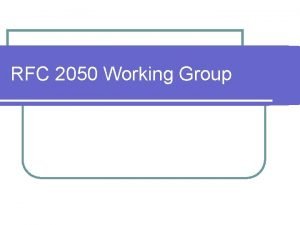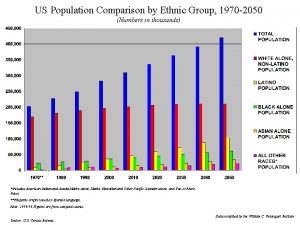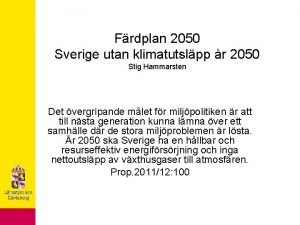Warming Commitments and reduction Commitments implications of 2050















- Slides: 15

Warming Commitments and reduction Commitments: implications of 2050 targets Bonn, June 16 2011 Michiel Schaeffer

Why do we need a 2050 target? • 2020 reductions are important to reduce warming and in particular to “bend the curve”: pre-condition for strong post-2020 reductions • but not sufficient in itself to reach 2/1. 5°C targets Level reached in 2100 based on current reduction proposals for 2020 of all countries Level reached in 2100 if in addition global emissions in 2050 are limited to 50% of 1990 (and CO 2 reaches zero by 2075) Source: Rogelj et al. (2011)

But is 50% by 2050 sufficient? • Leads to peak in GHG concentrations around 500 ppm and then stabilization at roughly 450 ppm • Long term 450 ppm: – 15% chance exceeding 3°C – 60% chance exceeding 2°C – 90% exceeding 1. 5°C Source: Schaeffer et al. (2008)

Ultimately 100% CO 2 reduction required • Due to very long time scales in uptake of CO 2 in the atmosphere by other parts of the Earth system, an (almost) 100% reduction in CO 2 emissions is required if stabilization of the climate system is to be achieved Source: Weaver et al. (2007)

2°C consistent budget: later reductions require faster AND deeper reductions (2000 Gt. CO 2 eq between 2000 and 2050) “overspending” “compensating” Source: Climate Analytics

Potential tipping points (large & abrupt changes – mostly irreversible ) Source: Hare & Schaeffer (2011)

Which °C target is achievable? Business as usual likely to exceed 3 o. C Global-mean temperature increase Source: Climate Analytics

Which °C target is achievable? Current targets & actions - 3 o. C or more Global-mean temperature increase Source: Climate Analytics

Which °C target is achievable? Lowest IPCC AR 5 scenario under 2 o. C Global-mean temperature increase Source: Climate Analytics

Which °C target is achievable? 85% pathway below 1. 5 o. C Global-mean temperature increase Source: Climate Analytics

Per capita emissions for 85% pathway Per capita emission evolution for World Population Prospects 18. 00 16. 00 14. 00 12. 00 10. 00 Kyoto. GHG excl. LU Change per cap [t. CO 2 eq/cap] 8. 00 6. 00 4. 00 2. 00 0. 00 Annex I Non-Annex I 1990 16. 53 3. 07 2000 15. 65 3. 09 2010 16. 41 3. 69 2020 8. 80 4. 55 2030 6. 07 2. 47 2040 3. 31 1. 48 2050 0. 72 0. 58 Source: PIK - PRIMAP

Sea-level rise very likely will not be stabilized with 2 o. C Source: Schaeffer et al (in preparation)

Rate of sea-level rise will not be lowered with 2 o. C Source: Schaeffer et al (in preparation)

CO 2 concentration with 2 o. C is far above viability limit for coral reefs Source: Hare et al (2010)

Conclusions • 50% reduction in CO 2 emissions by 2050 is feasible, but without further strong reductions this leads to: – over 2°C increase in time – higher impacts than 1. 5°C – higher risks, with 15% chance of >3°C • Due to long residence time CO 2 emissions ultimately need to be reduced by 100% • Budgets: the later 100% is reached, the higher the concentration level for centuries • If climate change resulting from reductions to 50 -100% below 1990 by 2050 is perceived as too high, or risky, post-2050 emissions need to be net-negative to reduce concentrations more rapidly than by natural removal
 Unauthorized commitments
Unauthorized commitments Sanctuary 7 commitments
Sanctuary 7 commitments Entry strategy and strategic alliances
Entry strategy and strategic alliances Core commitments for children
Core commitments for children Which nutrient practice was best journey 2050
Which nutrient practice was best journey 2050 Journey 2050 student handout 2 word search
Journey 2050 student handout 2 word search Social media in 2050
Social media in 2050 Natmap 2050
Natmap 2050 Rfc
Rfc Dálniční síť čr 2050
Dálniční síť čr 2050 Pas 2050
Pas 2050 Etip snet vision 2050
Etip snet vision 2050 Air pollution 2050
Air pollution 2050 Bevölkerungspyramide österreich 2050
Bevölkerungspyramide österreich 2050 Afghanistan population 2050
Afghanistan population 2050 2050-1970
2050-1970





























